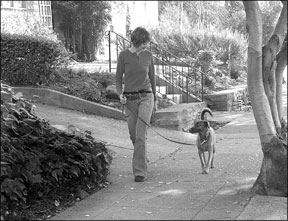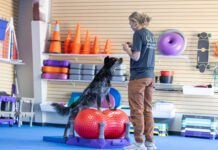Dog owners often bemoan the paucity of public places in our society where their dogs are welcome. We band together and lobby mightily to secure small spaces in our communities for dog parks. We struggle to preserve dog-use rights in public common areas. And while I share the dismay over the shrinking access for our canine companions, I know that to a large degree we’ve brought it on ourselves by our collective carelessness about proper public and leash-walking etiquette.
Picture yourself strolling down Main Street, your faithful companion stepping smartly alongside you on a loose leash. This is the image most pet owners have in mind when they adopt a warm fuzzy puppy, or offer to give a shelter or rescue dog a second chance for a lifelong loving home. In reality, however, walking the dog is more often a chaotic scene of canine dragging human down the sidewalk at the end of the leash, rudely approaching other dogs, jumping on passers-by, and snapping at the heels of joggers. Where did things go wrong?
What is a walk?
Much of the problem with ill-behaved dogs on leashes stems from the fact that many dog owners have a major misconception about exercise. A walk is a great social outing for you and your dog. It’s a good bonding experience, an opportunity for you to stretch your legs, and the perfect time to work on training generalizing your dog’s learned behaviors to new environments with new distractions.
What a walk is not, however, is adequate exercise for your dog. Unless you are a marathon runner, or your dog is elderly or has some physical problem, a walk around the block is simply an exercise hors d’oeurve for your furry pal.
Think about it. If you took your four-legged friend for a hike in the hills, off-leash (assuming it’s legal and he’d stay with you and has a decent recall), he’d run circles around you. And at the end of the hike, as you dragged yourself back to the car on tired legs, he’d still happily be making loops around you, begging for another trip around the trails. Face it. For most dogs, a polite walk around the block is rather slow and boring and if the energy level is high, some dogs will resort to lunging, barking, and worse, to spice up the experience.
Train, train, train
Another piece of the problem is simply a failure on the part of many owners to teach their dogs to walk politely on leash. Despite an emphasis on this important behavior in many good manners classes, some humans just aren’t motivated to practice reinforcing polite walking enough to make it a habit for them or their dogs. This is especially true in suburban and rural areas, where dogs have yards or farms to run in, as opposed to city-dwelling dogs whose only outlet for fresh-air exercise may be a walk on leash.
I personally find it very annoying to have a dog constantly yanking on my arm, so even though I live on 80 acres, I take the time to teach my dogs two different cues for walking: “Let’s walk,” which means “You can act like a dog occasionally stopping to sniff, pee, and explore as long as you don’t drag me,” and “Heel,” which means “Walk at my side, refrain from sniffing, sit when I stop.”
Teaching your dog to walk politely on leash is more than just a convenience. When you can walk in public with your dog following your moves like a dance partner, he’s more likely to stay out of trouble.
Teaching “Let’s walk”
Remember that your dog’s leash is not a steering wheel or handle. It’s a safety belt, intended to prevent your dog from leaving. It’s not to be used to pull him around, nor should he drag you along behind him.
Whether you’re teaching “Heel,” or the less formal “Let’s walk!” the correct position for the part of the leash that stretches from you to the dog is slack, hanging down in a valley. Be sure when your dog is with you that you keep the leash slack. If you keep it tight, he’ll think tension in the leash is normal and correct.
For left-side walking, start with your dog sitting by your left side. I suggest holding leash and clicker in your left hand (same side as the dog) and having a good supply of treats in your right hand. For right-side walking, just switch all the equipment to opposite hands. Make sure there’s enough slack in the leash so it stays loose when your dog is in the reinforcement zone you’ve identified for polite walking. You can also use a waist-belt or otherwise attach your dog’s leash to your person, as long as he’s not big enough to knock you down and drag you.
Use your “Let’s walk!” cue in a cheerful tone of voice and start walking forward. The instant your dog begins to move forward with you, use an audible marker, such as the click! of a clicker or the word, “Yes!” and give your dog a treat. (The click or “Yes!” is used to “mark” the behavior you want the dog to repeat, and the treat reinforces that behavior.)
At first, click! and treat very rapidly, with almost every step. Remember, you’re not teaching “Heel!” right now. Click! and treat as long as there’s no tension in the leash, although I do suggest you choose one side and reinforce on that side only, to keep him from crossing back and forth in front of you. When your dog realizes it’s worthwhile to stay within a designated radius of his generous, treat-dispensing machine (you!), you can gradually reduce the rate of reinforcement.
Careful! If you reduce the rate too quickly or too predictably, you’ll lose the behavior. As you gradually reduce the rate of reinforcement, be sure to click! and treat randomly so your dog never knows for sure when the next treat is coming. If he knows you’re going to reinforce every tenth step, he can get careless for nine steps, and zero back in on you on the tenth. This phenomenon is called an interval scallop or a post-reinforcement pause. We humans are creatures of habit, and easily fall into predictable patterns. And our dogs are masters at identifying patterns.
The manner in which you hold and deliver your treats is critical to success with polite walking. When you walk, have the treats in your hand but hidden behind your hip on the side opposite your dog. If you hold them in your hand on the same side where your dog can see or smell them, it will be harder to “fade” (slowly eliminate) the presence of the treats later on. If you hold them in front of you, your dog will keep stepping in front of you to watch your hand (treats), and you’ll keep stepping on him.
To deliver treats, wait for a second after the click! as you keep walking, then bring your hand across the front of your body and feed the treat. Quickly move your hand behind your hip as soon as you’ve delivered the treat. Feeding the treat in the location where you want your dog to be reinforces that position. If you’re teaching him to walk on the left, feed on the left side. If you’re teaching him to walk on the right, feed on the right. If you feed the treat in front of you, you’ll reinforce that position, and you’ll be stepping on him again.
Remember to click!, then give him a treat after a brief pause. If you begin to move your treat hand toward him before the click!, he’s just thinking about food rather than what he did to make you click the clicker.
For the same reason, you want to lure (hold the treat in the position where you’d like him to be) as little as possible during leash walking. Luring will keep him in position, but it interferes with his ability to think. Your goal is to get him to realize that walking in the desired reinforcement zone makes you click! the clicker, and earns him a reward.
Teaching the “Heel”
If your goal is a show-ring heel, continue to shape for a more precise position as previously described, until your dog will walk reliably with his shoulder in line with your leg. Then change your cue from “Let’s walk!” to “Heel!” so your dog can distinguish between “now we’re going for a relaxed stroll,” and “now we’re working for that perfect 200-point score.”
Of course, it sounds good in theory, but can’t possibly be that simple. There will be times when your dog forges ahead of you and tightens the leash, or stops to sniff something of interest as you walk past him. There are positive solutions for those challenges as well.
When you have to pass a very tempting distraction, go ahead and lure, briefly, to get your dog past it. Put a tasty treat at the end of his nose; the more tempting the distraction, the higher value the treat and walk him past. As his polite walking behavior improves, your need for luring should diminish.
About face
Direction changes can be useful in teaching polite leash walking. When your dog starts to move out in front of you, before he gets to the end of his leash turn around and walk in the opposite direction.
Do this gently; you don’t want him to hit the end of the leash with a jerk if he doesn’t turn with you! As you turn, use your cheerful voice and a kissy noise to let him know you’ve changed direction. When he notices and turns to come with you, click! and offer a treat. He’s now behind you, and you’ll have lots of opportunities to click! and treat while he’s in the loose-leash zone as he catches up and walks with you.
Be a tree
There will be times when your dog pulls ahead of you on a tight leash. This is a great opportunity to play “Be a tree.” When the leash tightens, stop walking. Just stand still like a tree and wait. No cues or verbal corrections to your dog. Be sure to hug your leash arm to your side so he can’t pull you forward.
Eventually, he’ll wonder why his forward progress has stopped, and look back at you to see why you’re not coming. When he does, the leash will slacken. In that instant, click! and feed him a treat at your side. The click! marks the loose leash behavior; he’ll have to return to the reinforcement zone to get the treat. Then move forward again, using a higher rate of reinforcement if necessary, until he’s walking politely with you again.
Penalty yards
If “Be a tree” is not working, add “Penalty yards.” Your dog usually pulls to get somewhere or to get to something. If he won’t look back at you when you make like a tree, back up slowly with gentle pressure on the leash, no jerking, so he’s moving farther away from his goal. This is negative punishment; his pulling on leash behavior makes the good thing go farther away. When the leash slackens, click! and treat, or simply resume progress toward the good thing as his reward.
Go sniff!
Sniffing is a natural, normal dog behavior. If you never let your dog sniff, you’re thwarting this important hard-wired behavior. He may become frustrated and aroused if he’s constantly thwarted, so when you’re doing polite walking together, sometimes give him permission to sniff.
If he stops to sniff keep walking, putting gentle pressure on his leash to bring him with you, giving him a click! and treat as soon as he moves forward. When you know you’re approaching a good sniffing spot, however, you can give him permission by saying “Go sniff!” Give him enough leash to reach the spot without pulling, even running forward with him if necessary. You can also use “Go sniff” as a reinforcer for a stretch of nice leash walking!
Pat Miller, CPDT, is Whole Dog Journal’s Training Editor. Miller lives in Hagerstown, Maryland, site of her Peaceable Paws training center. She is also the author of The Power of Positive Dog Training and Positive Perspectives: Love Your Dog, Train Your Dog.






